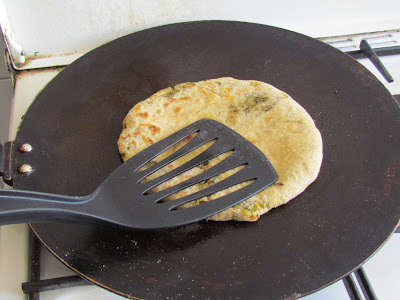 |
| Breakfast of Sadabahar Parantha with Mango pickle and Sweet Lime juice |
During
child hood I used to detest cauliflower vegetable though now it is one of my
favorite dishes specially when made with Peas or in Creamy Delicious Gravy /
Sweet and Sour Gravy. My mother used to be at her wits end as how to make me
eat the food when cauliflower vegetable used to be cooked. She being most
innovative house wife and a loving mother came up with the idea of stuffing the
vegetable and making stuffed paratha. When I started developing the taste she
slowly weaned me off this paratha and started serving me the vegetable. She
never forced us to eat anything but made us develop the taste for each and
everything so that we are not denied of nutrition for the want of taste.
Invariably
in my house left over vegetables would be lying in fridge which being less in
amount could not be served to the whole family. I borrowed the idea of my mom
did my own variations and came up with these soft, crispy, tasty and nutritious
parathas which can be served in breakfast/ lunch / dinner because they are
evergreen parathas.
Preparation
Time: 10 min.
Cooking
Time: 30min
Servings: 6
Parathas.
Ingredients
required for making dough for Parantha Sadabahar
- 150 gm. Whole Wheat Flour
- 1/2Teaspoon Salt
- 100 ml. Water
Ingredients
Required For Making filling Parantha Sadabahar:
- 2 Medium helpings of Left over dry vegetable (Cauliflower / Methi / palak / aloo)
- 1 Medium size Onion
- 1 Green Chili
- 2-3 sprigs of fresh Green Coriander leaves
- Salt to taste
- 1 Tea spoon Garam masala
Directions
For making filling for Parantha Sadabahar:
- Peel and cut the onion very fine.
- Cut green chili very fine.
- Wash and cut coriander sprig very fine.
- Mash the left over vegetable(s)
- If you have more than one left over vegetables then mix them together after mashing.
- If any vegetable has some liquid in it then cook it till it becomes dry them mash and add to other left over vegetable(s).
- Add
- Onion
- Green chili
- Coriander
- Salt (optional)
- Garam masala
- Amchur
- Mashed left over vegetable(s)
Direction
for making the Dough for Parantha Sadabahar:
- Take wheat flour in a bowl and add salt to it.
- Mix nicely.
- Add water little by little, mix and knead.
- The dough should be soft and pliable.
- If more water is required, add in little amounts as per requirement while kneading.
Directions
for Making Parantha Sadabahar:
- Divide the dough into 6 equal parts.
- Make a nice smooth round ball of one part.
- Make a cup shape from the dough ball by pressing the edges out and the center down wards .
- Divide the filling into 6 equal parts.
- Press the edges down and flatten the filled dough ball by pressing gently between your palms.
- Roll the flattened ball in wheat flour and sprinkle wheat flour on the rolling board.
 |
| Filled dough ball ready for rollin |
- Roll the filled ball rolled in wheat flour gently without applying too much pressure.
 |
| Rolled Parantha |
- Heat a tawa on high flame and when it becomes hot lower the flame and place the rolled parantha on hot tawa.
- Flip the paratha with the help of spatula and cook the other side also till it gains golden brown spots.
 |
| Cooked on one side and being cooked on the other side |
- Apply 1/2teaspoon oil / ghee on the upper side and flip so that the side with oil touches the hot surface of tawa.
- Press with spatula and cook for 30 sec.
 |
| Oil / ghee applied and being cooked by gently pressing with spatula |
- Apply 1/2 tea spoon oil the other side also and turn upside down.
- Remove from tawa on a serving plate and serve hot Parantha Sadabahar with curd/ pickle/ chutney/raita.
| http://jyotsna-pant.blogspot.com/2012/06/spicy-mixed-vegetable-pickle-less-oily.html |
| http://jyotsna-pant.blogspot.com/2011/10/green-coriander-and-mint-chutney.html |
| http://jyotsna-pant.blogspot.com/2012/06/mango-pickle-north-indian-style.html |
| http://jyotsna-pant.blogspot.com/2012/06/tangy-mango-pickle-maharashra-style.html |
- Do not use brinjal, pumpkin or any gourd vegetable for these parathas.
- The dough should be soft and pliable otherwise while rolling the stuffed dough ball it will crack from edges.
Suggested
Variations:
- If the left over vegetable has some gravy then cook it till it becomes dry.
- Left over dal from meals can be cooked to dry in wok and stuffed to make paratha, or mixed with mashed vegetable to make paratha.












































